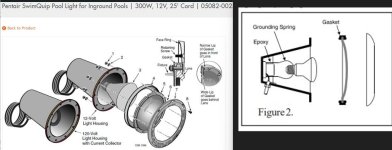I have old 12VAC niche fixtures where I'd like to screw in some 12V LED bulbs. Here's the trouble: I used a multimeter to measure voltage at screw in socket. It's 13VAC. But when I screw in the bulb I get no light. I shined up the socket with some fine sandpaper so I don't think corrosion is the problem. I also tried just holding a 12VAC little landscape bulb with pins on the two conductors of the socket. No light there either. Both bulbs lit fine using the wires at the junction box, so I know I have power to there.
Looks like there are some electronics in the base of the fixture potted in clear plastic. Is it possible those have gone bad, such that I'm not getting enough current? What do those electronics do?
Looks like there are some electronics in the base of the fixture potted in clear plastic. Is it possible those have gone bad, such that I'm not getting enough current? What do those electronics do?



